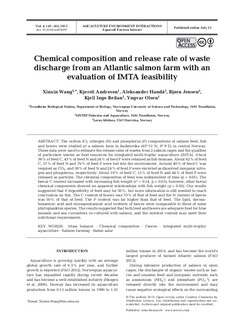| dc.contributor.author | Wang, Xinxin | |
| dc.contributor.author | Andresen, Kjersti | |
| dc.contributor.author | Handå, Aleksander | |
| dc.contributor.author | Jensen, Bjørn | |
| dc.contributor.author | Reitan, Kjell Inge | |
| dc.contributor.author | Olsen, Yngvar | |
| dc.date.accessioned | 2019-10-25T07:21:59Z | |
| dc.date.available | 2019-10-25T07:21:59Z | |
| dc.date.created | 2013-08-15T11:00:39Z | |
| dc.date.issued | 2013 | |
| dc.identifier.citation | Aquaculture Environment Interactions. 2013, 4 147-162. | nb_NO |
| dc.identifier.issn | 1869-215X | |
| dc.identifier.uri | http://hdl.handle.net/11250/2624325 | |
| dc.description.abstract | The carbon (C), nitrogen (N) and phosphorus (P) compositions of salmon feed, fish and faeces were studied at a salmon farm in Badstuvika (63°31’N, 9°9’E) in central Norway. These data were used to estimate the release rates of wastes from 2 salmon cages and the qualities of particulate wastes as food resources for integrated multi-trophic aquaculture (IMTA). About 38% of feed C, 43% of feed N and 24% of feed P were retained as fish biomass. About 62% of feed C, 57% of feed N and 76% of feed P were lost into the environment. Around 40% of feed C was respired as CO2, and 39% of feed N and 24% of feed P were excreted as dissolved inorganic nitrogen and phosphorus, respectively. About 19% of feed C, 15% of feed N and 44% of feed P were released as particles. The chemical composition of feed was independent of time (p > 0.05). The faecal C content increased with increasing fish weight (r2 = 0.14, p < 0.05); however, other faecal chemical components showed no apparent relationships with fish weight (p > 0.05). Our results suggested that P digestibility of feed may be 30%, but more information is still needed to reach conclusions on this. The C content of faeces was 70% of that of feed and the N content of faeces was 50% of that of feed. The P content was far higher than that of feed. The lipid, docosahexaenoic acid and eicosapentaenoic acid contents of faeces were comparable to those of some phytoplankton species. The results suggested that both feed and faeces are adequate food for blue mussels and sea cucumbers co-cultured with salmon, and the nutrient content may meet their nutritional requirements. | nb_NO |
| dc.language.iso | eng | nb_NO |
| dc.publisher | Inter-Research Science Publisher | nb_NO |
| dc.rights | Navngivelse 4.0 Internasjonal | * |
| dc.rights.uri | http://creativecommons.org/licenses/by/4.0/deed.no | * |
| dc.title | Chemical composition and release rate of waste discharge from an Atlantic salmon farm with an evaluation of IMTA feasibility | nb_NO |
| dc.type | Journal article | nb_NO |
| dc.type | Peer reviewed | nb_NO |
| dc.description.version | publishedVersion | nb_NO |
| dc.source.pagenumber | 147-162 | nb_NO |
| dc.source.volume | 4 | nb_NO |
| dc.source.journal | Aquaculture Environment Interactions | nb_NO |
| dc.identifier.doi | 10.3354/aei00079 | |
| dc.identifier.cristin | 1043330 | |
| dc.description.localcode | Copyright © 2013 Inter-Research. Open Access CC-BY | nb_NO |
| cristin.unitcode | 194,66,10,0 | |
| cristin.unitname | Institutt for biologi | |
| cristin.ispublished | true | |
| cristin.fulltext | original | |
| cristin.qualitycode | 1 | |

